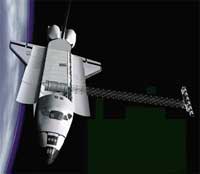 |
The Shuttle Radar Topography Mission (SRTM) in 2000 used a 60-meter deployable boom to support an outboard radar instrument.
|
For a number of years, deployable masts have been used in space missions to support solar arrays, magnetometers, cameras, and antennas. The Shuttle Radar Topography Mission in 2000, for example, used a 60-meter- (200-foot-) long mast to deploy one of two radar antennas. This was the longest mast ever deployed in space.
One of the next steps in development of deployable structures in space is to make them suitable to support large membrane structures such as solar sails. Solar sails use solar radiation photon pressure in much the same way that a sailboat uses wind. They promise to provide the means for high-speed interplanetary or interstellar propulsion. A rocket burns for only a few minutes before releasing its payload and letting it cruise at a constant speed the rest of the way to its destination. A solar sail, in contrast, keeps on accelerating and can ultimately reach speeds much greater than those of a rocket-launched craft.
To be useful for solar sails, deployable structures will need to be of gossamer lightness. Solar sails must be huge, typically about the size of a football field, to generate even as much force as the weight of a first-class letter. Even though this is a very tiny force, it is perpetual, and over days, weeks, and months, this snail-paced acceleration produces velocities large enough to overtake and pass the Voyager and Pioneer spacecraft launched in the 1970s that are now speeding away through the outer reaches of our solar system.
Besides their use in huge solar sails, ultra-lightweight deployable structure technology will also be useful for telescope sunshades, solar array assemblies, large aperture optics, instrument booms, and antennas. Examples of applicable missions include the following:
Sun Earth Connection (SEC): Solar Polar Imager (SPI), Magnetospheric Multi-Scale (MMS), Solar Sentinel (GeoStorm);
Structure and Evolution of the Universe (SEU): Advanced Radio Interferometry between Space and Earth (ARISE); and
Astronomical Search for Origins (ASO): Terrestrial Planet Finder (TPF), Filled Aperture InfraRed Telescope (FAIR), Life Finder (LF).